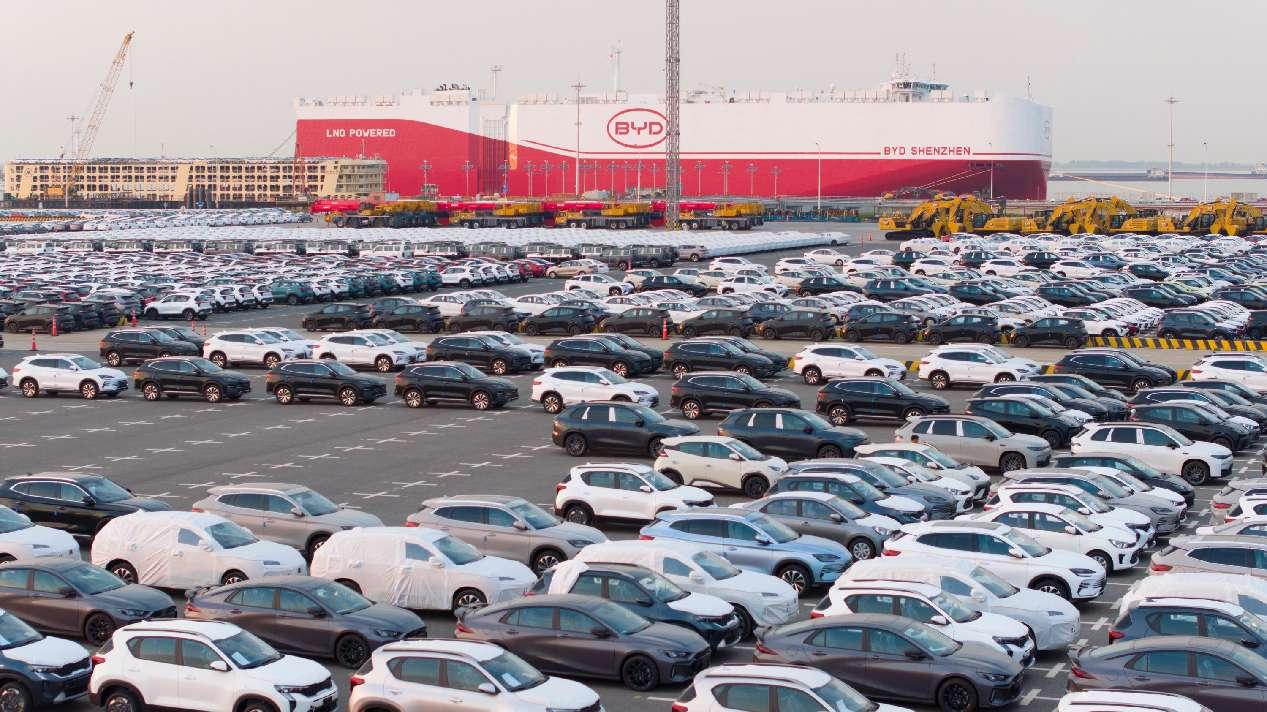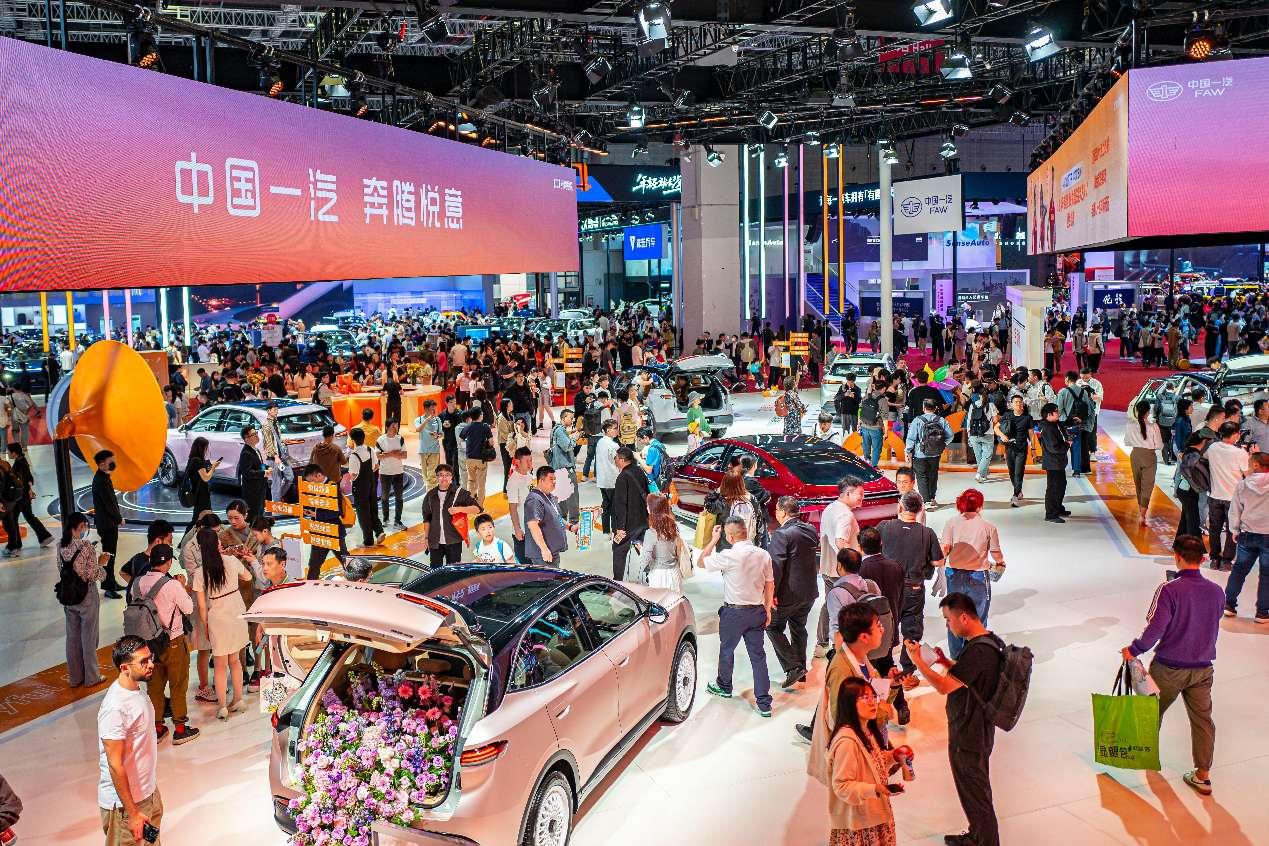




- BRNN
- BRI News
- BRNN News
- Database
Official Documents Polices and Regulations
Inter-government Documents International Cooperation BRI Countries
Business Guide Economic Data BRI Data
Trade
Investment Projects Latest projects
Cases - Content Pool

Robotic arms work in a smart workshop of a factory of Chinese new energy vehicle (NEV) manufacturer Leapmotor in Jinhua, east China's Zhejiang province, May 13, 2025. (Photo by Shi Bufa/People's Daily Online)
Despite the ongoing global economic headwinds, recent data from two key sectors provide compelling evidence of China's resilient economic trajectory.
On May 12, the China Association of Automobile Manufacturers reported that, for the first time ever, both production and sales of automobiles in China surpassed 10 million units in the first four months of the year, a year-on-year increase of 12.9 percent and 10.8 percent, respectively. Among these, exports of new energy vehicles (NEVs) reached 642,000 units, up 52.6 percent from a year ago.
The robust performance of the auto sector, a strategic and pillar industry, reflects the deeper logic behind China's high-quality development.
Additionally, customs data released on May 9 showed that China's total goods imports and exports in yuan-denominated terms expanded 2.4 percent year on year in the first four months of this year. In April alone, China's foreign trade was up 5.6 percent year on year, with exports rising 9.3 percent.
Despite global uncertainties, particularly in trade, China's manufacturing and innovation strengths have allowed the country to sustain its economic momentum.
Reuters reported that China's factory output showed surprising resilience in April, a sign that government support measures may have cushioned the impact of a trade war with the United States.
Together, these data points not only reflect the resilience of the Chinese economy but also its promising outlook for the future.
China's confidence in tackling risks and challenges stems from effective macroeconomic policy and capable governance.
According to China's Ministry of Commerce, the total number of applications for auto trade-in subsidies in China exceeded 10 million by May 11, under a mass renewal program initiated in 2024. International media outlets said this program has been particularly effective in counteracting the negative effect of U.S. tariffs on consumer confidence.
Beyond facilitating millions of vehicle upgrades, the program has significantly boosted sales of durable goods. In the first quarter, the policy helped drive a 19 percent year-on-year increase in investment in equipment and tools, and contributed to a 4.6 percent rise in total retail sales of consumer goods.
Moreover, the synergy between technological innovation and industrial upgrading is unlocking new momentum.
China's auto industry today is experiencing a surge in technological innovation, with major advancements being made in electric vehicle (EV) technology.
For instance, Chinese EV battery giant CATL recently launched a new brand for its sodium-ion battery with a life cycle of over 10,000 charges which retains 90% usable power at -40°C. Inside a welding workshop of Chinese automaker Guangzhou Automobile Group Co., Ltd. (GAC Group) in Yichang, central China's Hubei Province, over 500 robots work in sync, producing a new car every 52 seconds.
The shift toward high-end, intelligent, and green production is rapidly becoming standard practice. A more dynamic equilibrium -- where supply responds to demand and demand drives new supply -- has transitioned from a theoretical ideal to practical reality.

New energy vehicles are loaded onto the world's largest car carrier "BYD Shenzhen" at a terminal in Taicang, east China's Jiangsu province, which is bound for Brazil, April 27, 2025. (Photo by Yuan Xinyu/People's Daily Online)
At the recently concluded 21st Shanghai International Automobile Industry Exhibition (Auto Shanghai 2025), over 100 new models made their global debut, with over 70 percent being NEVs. Cutting-edge technologies were everywhere at the event. As Germany's Die Welt commented, anyone visiting Auto Shanghai 2025 would feel that the future has already come to China.
From technology importer to exporter, from attracting investment to making overseas investment, and from adapting to standards to setting them, China is gaining new competitive advantages and expanding its role in global cooperation.
In the first four months of 2024, China's high-tech exports rose 7.4 percent year on year, accounting for around 20 percent of the country's total exports and contributing to a 1.3 percentage point rise in overall export growth. This thriving "innovation ecosystem" is central to China's ability to navigate economic cycles and mitigate risks.
Green and low-carbon development is not only a long-term solution to environmental challenges but also a global trend. From January to April, China's NEV output and sales both exceeded 4 million units, marking a year-on-year growth of over 45 percent.
Chinese NEV manufacturers are intensifying efforts in renewable energy, energy efficiency, material recycling, and technological upgrades to reduce carbon emissions throughout the supply chain. NEVs are now ubiquitous on Chinese streets, and more and more young Chinese are choosing NEVs as their first cars. This symbiotic relationship between green production and green lifestyles is accelerating.

Photo taken on April 26 shows crowded exhibition booths at the 21st Shanghai International Automobile Exhibition (Auto Shanghai 2025). (Photo by Wang Chu/People's Daily Online)
Besides, Chinese manufacturing and global demand are also mutually reinforcing.
In the first quarter of this year, major destinations for Chinese auto exports included Mexico, the United Arab Emirates, Russia, Belgium, Saudi Arabia, Brazil, and Australia. A popular Brazilian auto influencer recently remarked that Chinese NEVs are becoming a new choice for car buyers in Brazil. Ricardo Bastos, president of the Brazilian Association of Electric Vehicles, emphasized: "We need clean energy to replace fossil fuels. This industrial transformation is sweeping the world."
By embracing the opportunities presented by digital and green transformation and by leveraging both global and domestic markets, Chinese smart manufacturing is not only meeting people's aspirations for a better life but also playing a pivotal role in the global transition to clean mobility.

Tel:86-10-65363107, 86-10-65368220, 86-10-65363106